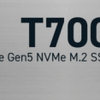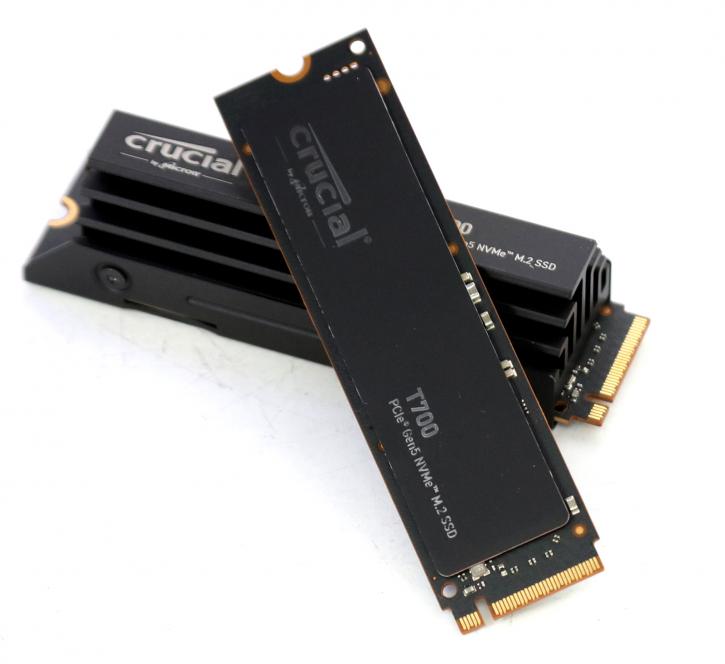Final Words & Conclusion
Final Words & Conclusion
We've been very excited to be able to test any new PCIe Gen 5 SSDs. Unfortunately, Phison can barely manage to cool the controller and NAND good enough. The Crucial T700 Gen 5 SSD encounters heat management issues, particularly regarding the controller and NAND. When the temperature reaches 90 degrees Celsius, the SSD performs a thermal shutdown, requiring a power cycle refresh to restore functionality (your data remains intact). During our testing, we found that without a heatsink and with only a bit of airflow, the SSD reached this temperature under a heavy workload within a dozen or so seconds. We feel that under no circumstance should an SSD be allowed to shut down. So Phison must address that issue with a firmware update and thermal throttling behaviour. Due to the aforementioned thermal challenges, using a heatsink with the Crucial T700 Gen 5 SSD is (pardon the pun) ... crucial. The included passive heatsink cooler is sufficient to address these issues. Crucial offers one for $30, but modern PCIe Gen 5-ready motherboards typically come with suitable SSD heatsinks embedded into the motherboard. Ensuring adequate airflow within your PC will help prevent thermal throttling and shutdowns. If the cooling conditions are met, then the Crucial T700 Gen 5 SSD delivers excellent overall performance, particularly in sustained performance tasks. Nevertheless, trace testing revealed results similar to those of enthusiast-class PCIe Gen 4.0 SSDs. Consequently, it remains unclear how much impact this SSD series, with its heat-related complications, will have on the market.
What do you need to do if a thermal shutdown happens to you?
Though firmware updates will fix it, a thermal shutdown can occur. To resolve this and regain access to the drive, it is recommended to shut down the computer completely through the power button or the Start Menu. After waiting for the system to power off entirely, press the power button to restart the computer. Following this procedure, the drive should reappear in the Device Manager, allowing for normal operation without any data loss. New future firmware will simply downthrottle the SSD to very low performance until it reaches an acceptable temperature again.
Exploring the Benefits of 10GB/s or Faster Storage Units
In the realm of storage units, whether we truly need 10GB/s or faster speeds has sparked debates among enthusiasts. Some argue that these premium performance products are often synthetically measured, requiring significant workloads to utilize their capabilities fully. While it's true that your average users may not experience significantly faster boot times, slightly quicker game loadings, or noticeably faster application start-ups compared to NVMe SSDs with read/write speeds in the 2 GB/sec range, there is more to consider. Let's delve into the that. While the average user may not perceive a substantial difference, individuals who invest in top-tier components like a GeForce RTX 4090 or Radeon RX 7900 XTX, coupled with a powerful processor like the Core i9 13900KS or Ryzen 9 7950X3D series, often seek that extra edge of performance, even if it may seem somewhat unrealistic. However, it's crucial to note that technological advancements, such as DirectStorage, will slowly be changing the landscape. With DirectStorage, graphics cards can directly access textures from the SSD, bypassing the processor and freeing up valuable processor cycles for other tasks. This technology significantly accelerates texture load times, providing a tangible benefit to those equipped with fast M.2 disks. Consider a scenario where you're launching a game with vast, intricate maps. With a fast M.2 disk and DirectStorage in action, you'll find yourself immersed in the game within seconds, an almost negligible loading time when compared to the long waits we've grown accustomed to. So, while the need for 10GB/s or faster storage units may not be immediately apparent, for those seeking every bit of performance, the potential gains in specific scenarios cannot be overlooked. Whether these gains are entirely realistic or not remains a topic for discussion.
Endurance
Crucial offers 600 TBW (Terabytes Written) for the 1TB model, 1200TBW for the 2TB model. We talked so much about this in the past already, endurance, the number of times NAND cells can be written before they burst and shatter into small pieces (well, they die and are mapped out, any data present on that cell is written to a healthy one). Bigger volume sizes mean more NAND cells; more NAND cells thus increase endurance. For the 2TB model, you'll get a rated 1200 TBW; the 1 TB model marks 300 TB written. So how long does a 1200 TWB storage unit last before NAND flash cells go the way of the dodo? Well, if you are an extreme user, you might be writing 50 GB per day (normal users likely won't even write that per week), but based on that value, 50GB x 365days= 18.25 TB per year written. So that's over 65 years of usage, double that for the 2TB SSD. And again, writing 50 GB per day is a very enthusiastic value.
Thermals
We know the E26 can get very hot, resulting in thermal throttling or a shutdown. It is MANDATORY to cool it under a heatsink.
Performance
The performance outcomes of the T700 PRO are quite remarkable, particularly in terms of sequential transfers. Crucials claim of "up to 12 GB/s" is indeed accurate, as we observed peak rates slightly above that threshold. However, this occurs at higher queue depths and thus sequential and lionear queed workloads. For typical consumer workloads at lower depths, you'll easily see 7 GB/s read and 9 GB/s write speeds, which are still mightily impressive. Random IO results and trace tests, however show this series to be virtually on par with those of PCIe Gen 4 drives, such as the Phison E18-NVMe SSDs. The T700 PRO has a big (dynamic) SLC cache allows that it to accommodate substantial incoming write bursts easily. We measured this close to 700 GB SLC cache; the maximum feasible size for a 2 TB TLC drive is achieved. pSLC writes can be very fast exceeding 9-10 GB/s, but when exhausted, transfer rates plummet, which is your typical TLC write hole.
Concluding
The Crucial T700 PRO SSD has generated considerable excitement due to its high-performance values. However, we raise concerns about heat dissipation. The SSD can overheat and be self-disable within 30 seconds under heavy workloads if installed without a proper heatsink. To restore functionality, a full power cycle is needed, which involves shutting down the PC. With the addition of a heatsink, the SSD's peak sustained and linear performance is awe-inspiring. However, it is paramount to weigh whether the price premium justifies the advantages it provides. Pricing will be a significant drawback for the Crucial T700 PRO SSD series. The 2TB model costs $340, or 17 cents per GB, which, while not excessive, is notably higher than fast 2TB PCIe Gen 4.0 SSDs priced at $175. This disparity in price and performance makes recommending the T700 PRO a challenge. Furthermore, achieving peak performance necessitates a compatible PCIe 5.0 motherboard and processor, restricting the SSD's usage to the most recent systems. As SSD prices continue to decrease, the premiums for PCIe 5.0 SSDs should also diminish as more options emerge. Drives featuring the faster Phison E26 controller are already expected to hit the market soon. Despite offering optional features and DirectStorage optimization, the T700 PRO seems like an early adopter product. The performance improvement over more affordable PCIe 4.0 drives is not significant enough to warrant the observed price premiums. As a result, users who do not require peak sustained read and write speeds, such as gamers or those conducting infrequent data transfers, should carefully consider whether the extra investment is justified. In conclusion, the Crucial T700 PRO is currently the top choice for those seeking the best-sustained performance, it delivers extraordinary speed in particularly that aspect. However, potential buyers should weigh the benefits against the price premium and consider whether they genuinely need the enhanced performance offered by this SSD. When you zoom out of sustained read/write performance, things look pretty 'PCIe Gen 4 normal'. A heatsink = mandatory, cooling is Crucial (pun intended).
Recommended Downloads


